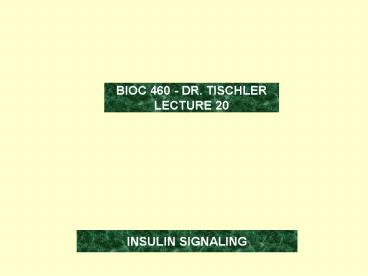BIOC 460 DR' TISCHLER - PowerPoint PPT Presentation
1 / 14
Title:
BIOC 460 DR' TISCHLER
Description:
Delineate steps for activation of tyrosine kinase of insulin ... amyloid deposition; fibrosis; -cell mass normal or moderate reduction. absence of -cells; ... – PowerPoint PPT presentation
Number of Views:50
Avg rating:3.0/5.0
Title: BIOC 460 DR' TISCHLER
1
BIOC 460 - DR. TISCHLER LECTURE 20
INSULIN SIGNALING
2
OBJECTIVES
- 1. Structures of proinsulin and insulin
significance of C-peptide. - 2. Mechanism for stimulation of insulin secretion
and synthesis by glucose by increasing
intracellular calcium. - Delineate steps for activation of tyrosine kinase
of insulin receptor including the role of
interchain autophosphorylation of tyrosine
residues - 4. Mechanism by which insulin mobilizes GLUT-4
transporter to - muscle/fat cell plasma membrane via IRS,
p85 and PI-3K. - 5. Compare causes of type 1 and type 2
diabetes what is meant by - insulin resistance in the type 2 form.
3
PHYSIOLOGICAL PREMISE Insulin receptor defects
are rare autosomal recessive disorders
characterized by intrauterine and postnatal
growth restriction, hyperinsulinemia (elevated
blood insulin), abnormal glucose homeostasis and
short life expectancy. Most cases have shown
affected patients to be either homozygotes (genes
on both chromosomes with the same defect), or
compound heterozygotes (defects in two or more
locations of the same gene on a single
chromosome) on mutations in the insulin receptor
(IR) ?-subunit. Such mutations impair insulin
signaling by decreasing IR expression on the cell
surface and/or IR affinity for insulin (strength
of insulin attachment). One patient was
identified with two mutant alleles of the IR gene
(allele any of the alternative forms of a gene
that may occur at a given locus). The maternal
and paternal alleles each contained a point
mutation (results from a change in a single base
pair in the DNA molecule, caused by the
substitution of one nucleotide for another)
causing structural alterations in the tyrosine
kinase domain of the IR ?-subunit resulting in
severe impairment of insulin action.
4
C-peptide secreted with insulin and cleared into
the urine
In the pancreatic ?-cell preproinsulin is
processed to proinsulin and then to insulin that
is secreted
Figure 1. The structural features of proinsulin
and insulin
5
6
Ca2
G L U T 2
Figure 2. Control of insulin synthesis and
secretion by glucose. CaM kinase
calmodulin-dependent protein kinase DAG
diacylglycerol
6
NH3
3HN
?-subunits
-S-S-
Insulin binding negative cooperativity
EXTRACELLULAR
-OOC
3HN
Plasma membrane
Transmembrane domain
Tyrosine kinase domain
CYTOPLASM
-OOC
COO-
?-subunits
Figure 3. The insulin receptor. Insulin binding
to the ?-chains transmits a signal through the
transmembrane domain of the ?-chains to activate
the tyrosine kinase activity
7
Extracellular
P
P
P
Cytoplasm
P
P
ATPs
ADPs
Figure 4. Activation of the tyrosine kinase
domains of the insulin receptor by insulin
binding, followed by interchain
autophosphorylation
8
Extracellular
P
P
P
P
P
P
Cytoplasm
Figure 4. Activation of the tyrosine kinase
domains of the insulin receptor by insulin
binding, followed by interchain
autophosphorylation
9
Control of the Insulin Receptor
- Insulin binding and subsequent dissociation
- Autophosphorylation to activate
- Serine phosphorylation to inactivate
10
Insulin Signal Transduction
- several targets are phosphorylated by IRTK
- IRS activation is tied to metabolic responses
- glucose transport (muscle and fat cells)
- activation of protein phosphatase
- protein phosphatase removes phosphates from
proteins phosphorylated by protein kinase A
counter-regulation of glucagon/epinephrine - growth responses are mediated via phosphorylation
of SHC ? increased synthesis of DNA and mRNA
11
Extracellular space Cytoplasm
GLUT-4
Active IRTK
1 IRTK catalyzed
p85
2 activated by docking active IRS
PI-3K
active IRS
Figure 5. Hypothetical mechanism for insulin to
mobilize GLUT-4 transporter to the plasma
membrane in muscle and adipose tissue. IRS,
insulin-receptor substrate IRTK, insulin
receptor tyrosine kinase PI-3K,
phosphatidyl-inositol kinase PDK
phospholipid-dependent kinase PKB, protein kinase
B
4 signals Golgi to traffic GLUT-4 to membrane
PKB
PDK
GOLGI
12
Step 5 Receptor inactivation
Step 6 translocation back to Golgi
Glucose
Step 2 translocation From Golgi
Step 4 Glucose transport
Golgi
(signal)
glucose
Step 3 Binding and fusion
transporter
-
P
P
-
Figure 6. Insulin stimulated glucose transport
(GLUT-4) in adipose or muscle cells
13
Type I versus Type II Diabetes
- Type 1
- Autoimmune destruction of pancreas ?-cells
- Lost ability to produce insulin
- Requires life-long insulin injection
- Lack of treatment leads to hyperglycemia
- Generally begins in children but may not appear
until 20s - Prone to ketoacidosis
- Type 2
- Initiated by reduced ability to respond to
insulin due to obesity (80 of cases) - Later characterized by lost ability to produce
insulin (50) - Hyperglycemia despite high blood insulin
- insulin resistance
- Generally begins in adulthood but is
increasingly seen in - teen and pre-teen years
- Potential to be a major epidemic
- Ketoacidosis unlikely unless insulin-dependent
14
Table 1. Other Comparisons of Type 1 and Type 2
Diabetes Mellitus































